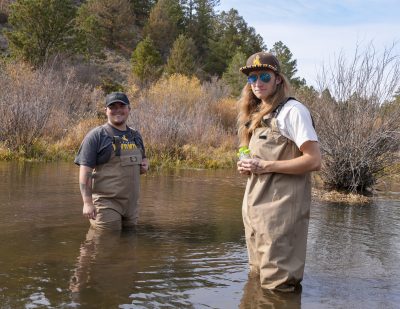From atmospheric science to zoology, the Life Sciences Program helps University of Wyoming undergraduates prepare for their futures.
Faculty in the Life Sciences Program teach over 2,000 UW students from more than 85 degree programs each year. The Life Sciences Program helps build a foundation in scientific concepts like cell biology, genetics, evolution, and ecology that are important to students from many fields.
“[The Life Sciences Program] often gets overlooked, but it’s a huge part of student success in the biological fields,” says Amy Rhoad, instructional professor in the Department of Veterinary Sciences and a teacher of several Life Sciences Program courses.
Building new skills
In addition to imparting information about scientific concepts, the Life Sciences Program teaches students critical thinking, scientific communication, ways to break down and analyze information, and research skills. Students learn how to read and write scientific papers, how to collect and interpret data, and how to formulate and test a scientific hypothesis.
“In LIFE 1010, I was introduced to the fundamentals of scientific writing, which have become incredibly valuable as I advanced in other courses, such as Animal Biology, as well as in the research lab I am part of,” says Lauren Lynde, a UW junior majoring in microbiology. “These experiences have not only enhanced my ability to engage with scientific literature but have also provided me with the confidence and skills needed to succeed in my coursework, research, and future career.”
Learning how to learn

Rhoad and other Life Sciences Program course instructors keep up with research on the most effective ways to teach students about science. Current research suggests that students remember and apply information better when they come up with their own research questions, learn about scientific concepts through stories, and experience active, hands-on education.
Rhoad leads many hands-on activities in her courses. In Animal Biology, for example, she asks students to try to find an item in a dark room, and then has them try again after wearing an eyepatch. After a short period of time, the cells in the eye covered by the eyepatch become very sensitive to light. Once removed, the newly light-sensitive cells can help the person find the item more easily.
By experiencing how their eyes adapt to light directly, students better understand the phenomenon and are more likely to remember that information than if it were only provided through a lecture or text.
Mentoring new coders
In the past two years, the Life Sciences Program has also begun to integrate the coding program R into its curriculum. By mentoring students through their first coding experiences, the program gives UW undergraduates a head start on digital literacy and data analysis skills that are vital in many fields.
The Life Sciences Program also harnesses research tools to continually improve their educational approaches. For example, Rhoad plans to conduct a research study on the impact of introducing R to undergraduates. “Freshmen are usually not quite to that level where they’re ready to really dive in, but the earlier we introduce it, the more they can build on those skills,” says Rhoad. Ultimately, she hopes that juniors and seniors who have been exposed to R for three or four years can become more proficient and more able to use coding as a tool to answer specific research questions.
By implementing and refining new ideas like coding and hands-on education, the Life Sciences Program embodies what it strives to teach: there’s always more to learn.
This article was originally published in the 2025 issue of Reflections, the annual research magazine published by the UW College of Agriculture, Life Sciences and Natural Resources.




